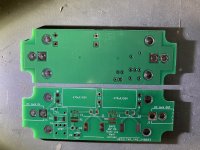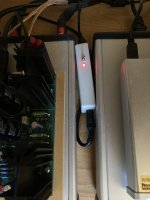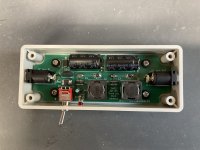If you have room you could try connecting the two filters in series to see if the noise floor drops even further. You could even test both possible sequential connections
_
- DC In ---> PO89ZB ---> AmyAlice ---> (ACP+ and ACAMini)
- DC In ---> AmyAlice ---> PO89ZB ---> (ACP+ and ACAMini)
_
Last edited:
Mark,
Brilliant work. I use the PO89ZB board with a LOT of projects around the house. I will have to order some boards and build some of these as I have done plenty of SMD work.
Any plans for higher current at that rail voltage? (sorry if I missed you already answering this).
Cheers,
Greg
Brilliant work. I use the PO89ZB board with a LOT of projects around the house. I will have to order some boards and build some of these as I have done plenty of SMD work.
Any plans for higher current at that rail voltage? (sorry if I missed you already answering this).
Cheers,
Greg
I recently put together a second ACP+ using the AmyAlice.
The two units are virtually identical, but one is using two PO89ZB boards in series and the other is using the AmyAlice.
The AmyAlice unit sounds better. Without going into audiophile terminology, the sound is more relaxed and seems to be coming from a blacker background.
The P089ZB is still worth building if you are not up for minimal SMD soldering. The only hard part for me was that third leg on the C1/C3 caps, but only because my eyes are not what they once were.
The two units are virtually identical, but one is using two PO89ZB boards in series and the other is using the AmyAlice.
The AmyAlice unit sounds better. Without going into audiophile terminology, the sound is more relaxed and seems to be coming from a blacker background.
The P089ZB is still worth building if you are not up for minimal SMD soldering. The only hard part for me was that third leg on the C1/C3 caps, but only because my eyes are not what they once were.
Hammett,
Have you built the Mini? It's excellent with a single PO89ZB. It's become one of my favorite amps, and I think it's about 98% of Nelson's other low power designs.
Cheers.
Greg
Have you built the Mini? It's excellent with a single PO89ZB. It's become one of my favorite amps, and I think it's about 98% of Nelson's other low power designs.
Cheers.
Greg
No concrete plans for beefier offshoots. But it is difficult to make predictions, especially about the future. (N. Bohr)
The AmyAlice unit sounds better. Without going into audiophile terminology, the sound is more relaxed and seems to be coming from a blacker background.
I had the same experience using the AmyAlice.
Newmark has the best pricing for all 6 components except the Wurth FB. That part only comes in a factory pack of 1000. How important is the ohms reading for this part. I cant find any exactly 880 ohms. I Can find 1.3k or 600 ohm. Would either of those work?
Thank you
Thank you
This project is not suitable for beginners or people who are completely lost without a Build Guide, assembly video, or tutorial. It requires SMD soldering which is a skill you develop by repetition and lots of practice.
You will need to order AmyAlice PCBoards from a PCB fab shop. I have written a quick Walkthrough that shows how to do this at the fab called "JLCPCB" (link); however the same principles and same steps are used at all fabs. Study the Walkthrough and I'm sure you will conclude: ordering PCBs is not mysterious, it's not complicated, and it's not at all frightening. It's exactly like buying anything else on an e-commerce website
Lots of DIYers have placed orders for AmyAlice boards, and have been delighted when they achieve complete success on the very first try.
Hi,
Presently building a 2.1 amplifier with 3 TDA8932, 24 VDC 4A power supply (FKSI). The WiiM Pro Plus will provide 12 VDC to power a single relay to power the PS, and a low pass filter (NE5532). So I came upon a thread from 2020 and it seems there is a revised version of the PO89ZB available.
1) Would the Amy Alice help solve the high pitch noise? I previously built a BT module with 2 OEM30W and was able to eliminate this noise issue by rerouting some wires. Perhaps replacing the PS. This time, no luck.
2) Are the caps still Kemet 470uf 50V (backorder at Mouser. Not on the Digikey BOM link!)
3) Sorry, I did not have time to read all the posts. I guess the blank PCB is available without having to pay for the engineering. Never ordered a blank PCB before, what is the best process?
A little nervous about SMD's but the picture posted really helps convincing me it is possible. Worth trying.
Thank you for providing assistance.
Robert
Presently building a 2.1 amplifier with 3 TDA8932, 24 VDC 4A power supply (FKSI). The WiiM Pro Plus will provide 12 VDC to power a single relay to power the PS, and a low pass filter (NE5532). So I came upon a thread from 2020 and it seems there is a revised version of the PO89ZB available.
1) Would the Amy Alice help solve the high pitch noise? I previously built a BT module with 2 OEM30W and was able to eliminate this noise issue by rerouting some wires. Perhaps replacing the PS. This time, no luck.
2) Are the caps still Kemet 470uf 50V (backorder at Mouser. Not on the Digikey BOM link!)
3) Sorry, I did not have time to read all the posts. I guess the blank PCB is available without having to pay for the engineering. Never ordered a blank PCB before, what is the best process?
A little nervous about SMD's but the picture posted really helps convincing me it is possible. Worth trying.
Thank you for providing assistance.
Robert
Tweezers and Flux and you will be surprised how easy SMD soldering is. 5 boards from JLCPCB is about 5 dollars CDN with shipping. But it will take about 2 weeks or so. Make an account at JLCPCB, then click on add file, pick your pcb board color and leave everything else as default. I found super duper cheap prices for the BOM at Newark, but will have to order the ferrite bead part through Digikey.
Thanks. Might stick with Digikey, Newark has 10$ shipping cost compared to 7 at DK.
Anyhow, would like some green light on going forward, i.e. would this circuit solve my issue.
Anyhow, would like some green light on going forward, i.e. would this circuit solve my issue.
^If you need certainty before trying it, you need to find the root cause of the "high pitch" noise.
I’ve been using smps with my class A amps now for a couple of years and not had any reliability problems yet. I was looking at ways to improve my power supplies when I came across the AmyAlice DC filter max 3A max 48v. Would it be worth using 4 of these (one on each rail on each channel) for a cleaner power supply?
Don't know if your amp rails requirements are within the specs of this SMPS filter, but if so I would vote for its use.
Several filters from Mark made wonders at mine and friends to DACs, preamps, power amps... all powered by quite clean quality SMPS, most having already a strong filter built in... but then they all improved.
And this filter is supposed to be even better than the ones I used so far...
Enjoy
Claude
Several filters from Mark made wonders at mine and friends to DACs, preamps, power amps... all powered by quite clean quality SMPS, most having already a strong filter built in... but then they all improved.
And this filter is supposed to be even better than the ones I used so far...
Enjoy
Claude
Here's a compact AmyAlice. It includes an optional switch circuit to kill the power and prevent "preamp turn on thump" when used with the ACA mini.
Note to MJ: I'm pretty sure I got it right, unlike my first run adaptation of the P089ZB.
Unfortunately, I don't have the test equipment to see if my layout performs equal to the MJ PCB but it sounds good to me!
Assembly notes: I used the manufacturer's footprint for the inductors and I find the pads are almost entirely hidden under the device. As a work around, I was able to solder one side and then slide it over a wee bit under heat to do the other side. Also, the double sided foam tape under the PCB did not have the protective strips removed as I only used it to provide some backing tension for the #2 PCB mounting screws. If you don't use the screws, you can use it as mounting tape. Getting the enclosure holes located exactly right is the hardest part. The input/output DC jacks can be slid fairly close to the insides of the box. I recommend tacking them to the PCB using only the + terminal and double checking the fit before final soldering.
Note to MJ: I'm pretty sure I got it right, unlike my first run adaptation of the P089ZB.
Unfortunately, I don't have the test equipment to see if my layout performs equal to the MJ PCB but it sounds good to me!
Assembly notes: I used the manufacturer's footprint for the inductors and I find the pads are almost entirely hidden under the device. As a work around, I was able to solder one side and then slide it over a wee bit under heat to do the other side. Also, the double sided foam tape under the PCB did not have the protective strips removed as I only used it to provide some backing tension for the #2 PCB mounting screws. If you don't use the screws, you can use it as mounting tape. Getting the enclosure holes located exactly right is the hardest part. The input/output DC jacks can be slid fairly close to the insides of the box. I recommend tacking them to the PCB using only the + terminal and double checking the fit before final soldering.
Attachments
- Home
- Amplifiers
- Power Supplies
- AmyAlice: DC filter for SMPS, using 2 feedthru capacitors + SMD assembly. max 3A & max 48V


